We’re all users, visitors, and customers — and we all have expectations when engaging with websites and digital services. But let’s be honest: things often go wrong.
Whether it’s struggling to locate a button, encountering unclear information, or dealing with a clunky user experience, these issues highlight gaps that demand attention. This is where Conversion Rate Optimisation (CRO) excels. By identifying and testing potential improvements, CRO uncovers friction points, helping to refine and optimise digital experiences.
Over the past decade, our team have refined a proven methodology that not only pinpoints where to make improvements but also identifies the right questions to ask. Here’s an in-depth look at that process.

1. Define Business Type and Goals
The first step is to define the website’s primary goal. Understanding whether a business operates in a B2B or B2C environment shapes how we assess user behaviour and define success:
- B2B Goals: Typically revolve around lead generation, often through contact forms, whitepaper downloads, or demo requests.
- B2C Goals: Focus on driving purchases or subscriptions, with user actions aimed at completing transactions or adding items to the basket.
2. Analyse Structure, Funnels, and User Flow
Once the goal is clear, the next step is to map out the user journey and identify points of friction:
- User Flow Mapping: For B2B, this might involve understanding the steps leading to a form submission. For B2C, it’s about tracking the path to purchase and identifying potential drop-off points.
- Conversion Funnels: Analysing traffic sources and key drop-off areas helps prioritise which areas require the most attention.
- Device Split Analysis: Users behave differently depending on the device. Research shows that 58% of website visits now come from mobile devices (Statista), making mobile optimisation essential.
- Top Pages and Bounce Rates: Understanding which pages attract the most traffic — and where visitors leave — helps uncover usability gaps.

3. Conduct a Comprehensive UX Review
This stage involves a deep dive into the website experience, factoring in user expectations, device types, and visual differences. The goal is to assess how seamlessly users can complete their intended actions.
Key questions include:
– Is the desired information easy to locate?
– Are CTAs (calls to action) clear and engaging?
– Are there unnecessary blockers slowing the journey?
Our experts use FigJam (similar to Miro) to visualise the journey, adding colour-coded post-it notes that highlight what works well, where issues arise, and what could be tested.
4. Develop Actionable Test Ideas
Once problem areas are identified, the next step is to break down these insights into actionable test ideas. This phase involves:
- Identifying test opportunities based on user pain points.
- Mapping out the areas where tests will be conducted.
- Defining key success metrics beyond revenue alone.
CRO isn’t just about driving revenue — it’s about enhancing the overall user experience. Improving site usability boosts customer perception, loyalty, and trust, even if conversion happens later or through another channel.

5. Create Mockups, Develop, and Set Up Tracking
To visualise potential changes, I often create mockups to compare the proposed improvements with the current experience. Depending on the complexity, I use either Figma or code directly to streamline the design-to-development process.
Additionally, this stage includes:
– Setting up tracking and analytics to monitor test performance.
– Ensuring the correct events are tracked to measure success accurately.
– Defining primary conversion points to gauge improvements effectively.
6. Go Live: Running the Test
Once stakeholders are aligned and the preview link has been approved, it’s time to schedule the test go-live date. The duration and audience split for the test are determined by factors such as:
- Current conversion rates.
- Daily visitor volume.
- Estimated improvement percentage.
A/B tests should typically run for 2-4 weeks to ensure statistically significant results. According to VWO, companies running continuous A/B tests see an average 49% improvement in conversion rates over time.

7. Analyse and Report Test Results
Post-test analysis is where insights transform into actionable changes. Using Frequentist and Bayesian statistics, I evaluate the test’s statistical significance and ensure that results aren’t based on random chance.
- Frequentist Method: Determines how likely the observed results are under the null hypothesis.
- Bayesian Method: Estimates the probability that a variation is better than the control.
If the improvement is repeatable and statistically significant, the next step is either full implementation or iterating on the test for further refinement.
8. Reporting and Continuous Optimisation
CRO isn’t a one-time activity. Every test provides insights that feed into future optimisation cycles. Whether a test wins or loses, the data reveals valuable patterns about user behaviour that inform the next round of testing.
The CRO process is cyclical. Each iteration refines user journeys and brings the website closer to meeting user expectations.
Ready to Improve Your Website?
If you’re ready to enhance your website’s performance, increase conversions, and improve the overall user experience, contact us today. Whether you’re optimising for lead generation or e-commerce purchases, a structured CRO approach can unlock significant improvements that align with your business goals.



